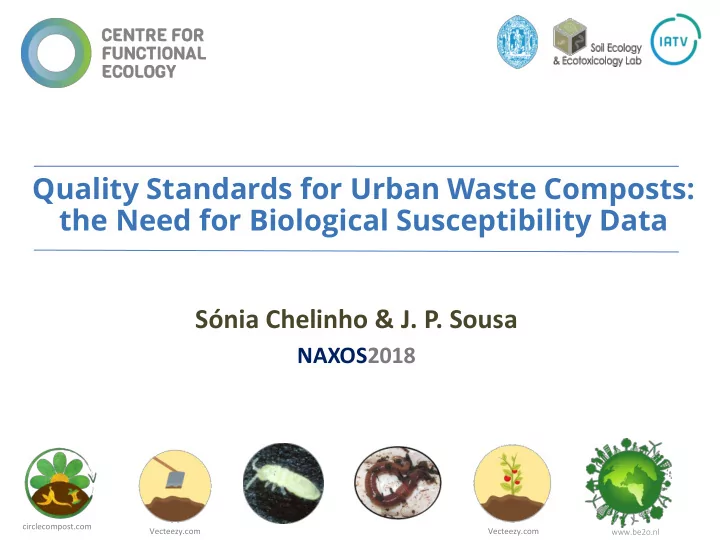

Quality Standards for Urban Waste Composts: the Need for Biological Susceptibility Data Sónia Chelinho & J. P. Sousa NAXOS2018 circlecompost.com Vecteezy.com Vecteezy.com www.be2o.nl
I. I. EU Cir ircula lar Economy Package Quality Harmonization of Fertilizers (e.g. UWC *) Needs Compliance with European Recycling Targets Lack of information / mistrust Competition with other organic fertilizers Problems Market Rejection Certification of the environmental quality of UWC Increased added value Solutions Stimuli of UWC production / flow * Urban Waste Composts Sónia Chelinho & José Paulo Sousa
I. Effects Evaluation and UWC Quality Actual regulation: based on pH – 7.5 External physic-chemical analysis % OM: 53 Effects on ecological dose (D.L 103/2015; Saveyn & [Cu] – 300 ppm [Hg] – 0.8 ppm Eder, 2014) receptors ? … Contaminant fraction absorved by target- organisms (bioavailability)? Food safety? Toxicity level? http://eusoils.jrc.ec.europa.eu Sónia Chelinho & José Paulo Sousa
I. Goals o To evaluate the impact of soil amendment with five UWCs in using ecotoxicological tests with representative soil organisms. o To develop an environmental quality certification system for the use of UWCs in agricultural systems. Working hypothesis The application of low quality UWCs (from mixed urban wastes) will be associated with higher hazard (ecotoxicity). Sónia Chelinho & José Paulo Sousa
I. Soil Ecotoxicological test in brief Evaluation of effects derived from exposure to chemical/stressors using soil inhabitants ( chemical vs biological system interaction); Estimation of concentration where no effects are observed; Extrapolation to define exposure levels considered safe for populations and ecosystems. www.ladailypost.com [ [ No Observed Effects] Sónia Chelinho & José Paulo Sousa
M&M. Summary of Test-Materials and Doses 5 UWC 2 from source separated urban organic wastes (SS1 and SS2) 3 from organic fraction of mixed urban wastes (MW1, MW2, MW3) 1 natural soil (pH=5.85; OM=2.9%; sandy loam) Soil-UWC dilutions ( 0.7*, 2.1, 6.3, 18.9 and 56.7%) ** 0.7% = Maximum Annual Dose (MAD**) for mixed-waste- composts (10t /ha) * Average soil density of 1.5 g soil / cm3; 10cm incorporation 3,33% = MAD** for source-separated-composts (50 t/ha) * PT legislation (DL 103/2015) Sónia Chelinho & José Paulo Sousa
M&M. Test-Battery Common name Species Endpoint (Taxonomic group) Avoidance Behaviour Eisenia andrei Earthworms (Annelida) Reproduction Avoidance Behaviour Folsomia candida Colembolans (Arthropoda) Reproduction Enchytraeus crypticus Enchytraeids (Annelida) Reproduction Lactuca sativa Lettuce (Magnoliophyta) Germination and Growth. Triticum aestivum Wheat (Magnoliophyta) Sónia Chelinho & José Paulo Sousa
R. Earthworms reproduction Low UWC doses (up to 6.3%): Reproduction similar to the control. * Statistically lower than the control (Anova, Dunnet Test, p <0.05) Sónia Chelinho & José Paulo Sousa
R. Ranking of ecotoxicity (1-Most; 5- Least) Common name Test-species Endpoint SS1 SS2 MW1 MW2 MW3 (Taxonomic group) Avoidance behaviour 1 5 2 4 3 Eisenia andrei Earthworm (Annelida) Reproduction / Mortality 1 5 2 4 3 Collembola Avoidance 3 4 1 5 2 Folsomia candida (Arthropoda) Reproduction 1 5 4 2 3 Enchytraeus crypticus Enchytraeis (Annelida) Reproduction 1 5 2 4 3 Lettuce (Magnoliophyta) Germ./Growt Lactuca sativa 1 5 2 3 4 h Germ./Growt Triticum aestivum Wheat (Magnoliophyta) 1 5 2 3 4 h Sónia Chelinho & José Paulo Sousa
D. Species sensitivity and UWC Toxicity Wheat < Lettuce < Enchytraeids < Collembolans < Earthworms SS2 < MW1 < MW3 < MW1 < SS1 Sónia Chelinho & José Paulo Sousa
D. Physic-chemical Characterization Parameter (unit) SS1 SS2 MW1 MW2 MW3 MW1 > MW3 > MW2 > SS1 > SS2 pH 8.1 8.3 7.2 7.8 7.1 (“ Expected ” r ange of toxicity) 7.4 3.1 6.64 4.3 5.17 EC (mS cm/1, 25ºC) 4.1 1.6 3.6 2.3 2.7 Salinity (25ºC) SS1 > MW1 > MW3 > MW2 > SS2 (Observed range of toxicity) OM (%) 42.73 46.74 37.26 43.62 44.21 Total N (%) 2.87 1.51 1.65 1.63 1.89 NO3- (mg/kg) 45 634 1500 720 892 No direct relationship between NH4+ (mg/kg) 84 54 46 58 80 metal concentration and observed toxicity. C/N 8.05 13.64 9.21 11.34 8.87 Cd (mg/kg) 2.78* 1.68 4.18* 2.98 2.78 Pb (mg/kg) 44 43 235 197 242 Cu (mg/kg) 41 26 204 184 336 Cr (mg/kg) 28 34 100 63 107 Ni (mg/kg) 21 19 67 52 34 Zn (mg/kg) 98 64 149 149 151 Probable cause: UWC High salinity Hg (mg/kg) 0.06 0.06 0.37 0.61 0.37 * Above PT legislation limits (Dl 103/2015)
C. Conclusions & Future Work The application of the recommended doses of UWC (0.7 and 2.1%, i.e., MAD and 3xMAD), seems to be beneficial for the organisms when compared with the control; However, in scenarios of over-application or application of high salinity UWCs, there might be significant ecotoxicological effects (e.g. soil invertebrates); Physical-chemical characterization of UWCs does not reflect the potential environmental risk associated with their application; The inclusion of the biological effects assessment in the quality characterization of UWC is essential; Future work: Field trial with the UWC with highest associated risk. Sónia Chelinho & José Paulo Sousa
TH THANK YOU FOR YOUR ATTENTION! sonia.chelinho@iav.uc.pt https://www.facebook.com/labsolos https://www.facebook.com/CFEUC http://blog.globalsoilbiodiversity.org/ Sónia Chelinho & José Paulo Sousa
Recommend
More recommend